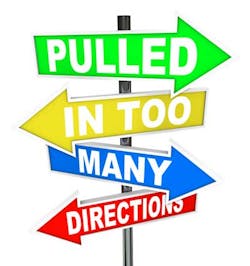7 signs your dental practice is busy, but not productive
So what’s your definition of “busy”? Is it a patient reception area that’s brimming with patients? A schedule that has you and your energized staff doing hallway sprints from 8 a.m. to 5 p.m.? Is it a day that keeps you and your team at the top of your game and on track with your goals?
In far too many practices, “busy” means frantic but far from financially sound. Why? Because the business team members are doing precisely what the doctor has told them to do. Keep him or her ... well ... busy. Yet in spite of the persistent pace, production continues to lag and profits don’t measure up. The doctor is at a loss trying to figure out why.
After all, just look at the schedule. There’s barely an opening to be found. Naturally, dentists will assert with utmost conviction that their “full” schedule is an indication of a successful practice. The “keep the doctor busy” scheduling strategy seems to be working, so why don’t the numbers back this up? In the dental practice, busy is often an illusion that doesn’t necessarily translate to productive. A busy-but-not-productive practice has a number of telltale signs:
1. The doctor is booked more than three weeks out, and patients have to wait several weeks for even the most routine procedures.
2. There is little if any consistency in the time scheduled for procedures, ranging from 30, 60, and 90 minutes.
3. The objective is simply to keep the schedule full.
4. The hygiene schedule is booked for months.
5. “Lunch hour” is a nice euphemism for 10-minute lunch breaks for the team to catch their breath and grab their protein bars.
6. Patient retention is weak.
7. Revenues are flat.
I recommend taking your focus off of being merely “busy” and paying attention to what it means to be truly productive.
First, define goals, objectives, and priorities. Develop a clear picture of the practice’s financial demands. It is the first and most critical step in understanding the importance of scheduling to meet daily production goals.
You need to consider the fundamentals, including the following: How much are your bills? How much do you need/want to pay your staff and yourself? How many hours per day and days per week do you want to work? How much vacation time do you want to take? What about costs for bonuses, retirement, continuing education, equipment upgrades and maintenance, and more? All of those financial needs and desires play a role in determining the practice’s revenue goals.
Next, you need to set production objectives. Rule No. 1 in building a profitable dental practice is to ensure that the scheduling coordinator is scheduling to “meet” production objectives vs. scheduling and “hoping” to meet the goal. Set scheduling goals by basing them on your overhead expenses. Scheduling goals are sometimes pulled from the air, and then you scratch your head and wonder why you’re not reaching the objective.
Setting a production objective requires you to know your overhead expenses. How much money does it take to pay the bills and payroll? Let’s say expenses and payroll total $46,500 per month and your objective is to have overhead be no more than 62% of your monthly collections.
So, $46,500 is 62% of $75,000 in collections per month (46,000 ÷ .62). If you’re collecting at a 98% collection ratio (collection divided by net production) you will need to produce $76,531 per month (75,000 ÷ .98). If you work 48 weeks a year, which is four working weeks a month, and see patients four days a week, that equals $4,783.19 per day in net production.
The industry standard for hygiene is 33% of the practice production, which means hygiene needs to produce $1,578 per day and the doctor needs to produce the difference of $3,205. Working an eight-hour day, this equals $401 per hour. If you’re seeing patients on 10-minute units and there are six units in an hour, the doctor must have net production scheduled at $67 per 10 minutes.
By following these guidelines, from here on out you’ll be productive as opposed to just busy.
ALSO BY SALLY MCKENZIE:
10 steps to solid fees for your dental practice
Why can’t you pull the trigger on that dental practice purchase?
Sally McKenzie is CEO of McKenzie Management, a nationwide dental management, practice development, and educational consulting firm. Working on-site with dentists since 1980, McKenzie Management provides knowledge, guidance, and personalized solutions that have propelled thousands of general and specialty practices to realize their potential. She can be reached at 877-777-6151 or [email protected].


